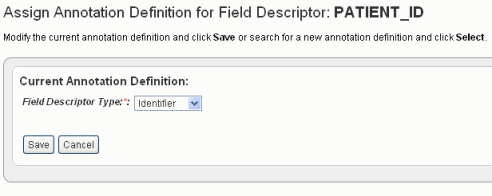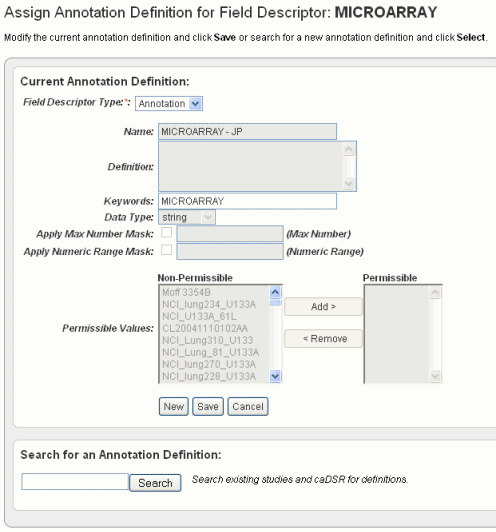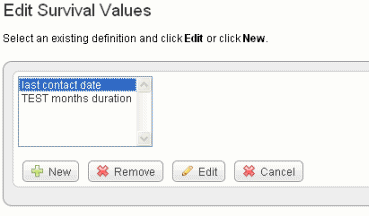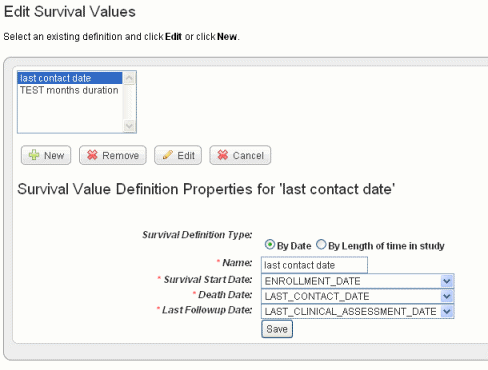 |
Page History
...
If this Define Fields page opens after clicking the Edit Annotations button, working with this page is identical for both subject and image annotations
The
...
To add subject or image annotation metadata in this page, follow these steps:
- You can specify visibility of specified annotation data in the Visible column.
- Select a checkbox for a row to make the corresponding data visible to all subscribers of the study or anonymous users if the study is made available to the public.
- Clear a checkbox to hide the corresponding annotation from any subscriber or anonymous user of the study. Data continues to exist but does not show up in query fields nor in query results.
- The Annotation Header from File column on the Define Fields for Subject (or Image) Data page (the figure shown above) displays column headers taken from the source CSV file. The Define Fields... page also displays data values in the file you have designated. You must map each column name to an existing column name in the caIntegrator database or in caDSR. If it doesn't yet exist, you can create a custom column name. The following figure is an example CSV file whose data you would be mapping in caIntegrator in the Define Fields page.
The MOST important steps in creating a new study in caIntegrator are these:
- You MUST designate one column in the file as a unique "identifier" column type.
- You MUST review and define column annotation definitions for each column header in the file.
Note the following regarding the list of annotations on this Define Fields... page:- – If caIntegrator "recognizes" the same column header in other files already in the system, a term, for example "age" or "survival", which is the current definition, appears in the Annotation Definition column above the blue Change Assignment link on the page.
- – When the annotation definition has not been assigned, and the area above the blue Assign Annotation Definition link is blank on this page, no correlating term exists in the database. In this case, you must specify the field type, and then the term will populate the space. See #Assigning an Identifier or Annotation for more information.
- – A field name that displays in red indicates an error in the annotation. Click the Change Assignment button for more information about the error.
...
MOST important steps in creating annotation definitions on this page are these:
* You MUST designate one column in the file as a unique "identifier" column type.
* You MUST review and define column annotation definitions for each column header in the file.
Note the following regarding the list of annotations on this Define Fields... page:
- If caIntegrator "recognizes" the same column header in other files already in the system, a term, for example "age" or "survival", which is the current definition, appears in the Annotation Definition column above the blue Change Assignment link on the page.
- When the annotation definition has not been assigned, and the area above the blue Assign Annotation Definition link is blank on this page, no correlating term exists in the database. In this case, you must specify the field type, and then the term will populate the space. See #Assigning an Identifier or Annotation for more information.
- A field name that displays in red indicates an error in the annotation. Click the Change Assignment button for more information about the error.
The first column of the table on this page displays annotation groups that have been created for this study. For more information, see #Adding an Annotation Group.
To add subject or image annotation metadata in this page, follow these steps:
- You can specify visibility of specified annotation data in the Visible column.
- Select a checkbox for a row to make the corresponding data visible to all subscribers of the study or anonymous users if the study is made available to the public.
- Clear a checkbox to hide the corresponding annotation from any subscriber or anonymous user of the study. Data continues to exist but does not show up in query fields nor in query results.
- The Annotation Header from File column on the Define Fields for Subject (or Image) Data page (the figure shown above) displays column headers taken from the source CSV file. The Define Fields... page also displays data values in the file you have designated. You must map each column name to an existing column name in the caIntegrator database or in caDSR. If it doesn't yet exist, you can create a custom column name. The following figure is an example CSV file whose data you would be mapping in caIntegrator in the Define Fields page.
- To indicate the unique identifier of choice, on the row showing the column header (PatientID in the figure, but other examples are subject identifier, sample identifier, etc), click Change Assignment in the Annotation Definition column.
Assigning An Identifier or Annotation
When you click Change Assignment on the #Define Define Fields page, the Assign Annotation Definition for Field Descriptor dialog box opens. On this page you can change the column type and the field definition for the specific data field you selected.
...
- For the column that you choose to be the one and only Identifier column (in this case, PatientID), in the Column Type drop-down list, select Identifier. The following figure shows the dialog box rendering when "identifier" is selected in the Field Descriptor Type drop-down list.
- Click Save to save the identifier. This returns you to the Define Fields for Subject Data page where the Identifier is noted in the Annotation Definition column.
- After you have defined which field is the Identifier, you must ensure that ALL other data fields also have an annotation definition assignment. For those fields without an annotation definition assignment or for those whose annotation definition you want to review, click Change Assignment.
- In the Assign Annotation Definition for Field Descriptor dialog box, shown in the following figure, select Annotation in the drop-down list.
As you select the column type, you can work with column headers in one of four ways in this dialog box.
## You can accept existing default definitions (those that are inherent in the data file you selected). See Step 5.
## You can create and/or manage your own definitions manually. See Step 6.
## You can search for and use definitions in other caIntegrator studies. See #Searching for Annotation Definitions.
## You can search for and use definitions found in caDSR. See #Searching for Annotation Definitions.
- 5. Review the current annotation definition in the Assign Definition page, Current Annotation Definition section. Click Cancel to return to the Define Fields... page.
You can still initiate a search for another annotation definition in the Search for an Annotation Definition section on the browser page if you choose to change the definition. See the following figure. See also #Searching for Annotation Definitions. Click Save to retain any changes. - 6. To enter a new name annotation, or any other information about the annotation definition, click the New button and enter the information described in the following table. #Data
Annotation Field
Field Description
Name
Enter the name for the annotation.
Definition
Enter the term(s) that define the annotation.
Keywords
Insert keyword(s) that could be used to find the annotation in a search, separated by commas.
Data Type
Select a string (default), numeric, or date.
Apply Max Number Mask
This field is available only for numeric-type annotations, or when a new definition is created. This feature is unavailable when permissible values are present.
Select the box and enter a maximum number for the mask, such as "80" for age. When you query results above the value of the mask, then the system displays the mask and not the actual age.
Note: If you enter masks of both "max number" and "range", caIntegrator applies both masks at the same time.
TheData Dictionary page now has a Restrictions column that shows restrictions whenever a mask has been applied.
Apply Numeric Range Mask
This field is available only for numeric-type annotations, or when a new definition is created. This feature is unavailable when permissible values are present.
Select the box and enter a width of range for the mask, such as "5" representing blocks of 5 years. For example, if you enter a width of 5, the query only allows age blocks of 0-5, 6-10, 11-15, etc.
When you query results above the value of the mask, then the system displays the mask and not the actual age ranges.
Note: If you enter masks of both "max number" and "range", caIntegrator applies both masks at the same time.
The Data Dictionary page now has a Restrictions column that shows restrictions whenever a mask has been applied.Permissible/Non-permissible Values
Note: The first time you load a file, before you assign annotation definitions, step #3 in #Assigning An Identifier or Annotation, these panels may be blank. If the column header for the data is already "recognizable" by caIntegrator, the system makes a "guess" about the data type and assigns the values to the data type in the newly uploaded file. They will display in the Non-permissible values sections initially. Use the Add and Remove buttons to move the values shown from one list to the other, as appropriate.
When you select or change annotation definitions by selecting matching definitions (described in #Searching for Annotation Definitions), this may add (or change) the list of non-permissible values in this section.
...
- Make sure that you have defined at least three fields set to the "date" Data Type. These will be matched to the following three properties during Survival Value definition.
- Survival Start Date
- Death Date
- Last Followup Date
- It is also possible to generate KM plots if an Annotation Field Descriptor such as DAYSTODEATH has been set to Data Type 'numeric'. See #Assigning an Identifier or Annotation.
| Info | ||
|---|---|---|
| ||
Setting survival values is optional if you do not plan to use the K-M plot analysis feature or if you do not have this kind of data (survival values) in the file |
...
. |
For some applications, such as REMBRANDT and I-SPY, survival values are pre-defined in the databases when you load the data. In caIntegrator, however, you can review and define survival value ranges in a data set you are uploading to a study. To be able to do so, you need to understand the kind of data that can comprise the survival values.
...
- On the Edit Study page, click Edit Survival Values. This opens the Survival Value Definitions dialog box, shown in the following figure.
- Click New to enter new survival value definitions.
- OR -
Click Edit to edit existing survival value definitions.
The dialog box extends, now displaying radio buttons and three drop-down lists that show column headers for date metadata in the spreadsheet you have uploaded. If survival value ranges have already been added to a study, they display on the page. The dialog box is shown in the following figure.
- Survival values can be defined by Date or by Length of time in the study. Select the radio button for the category that defines your survival data.
- In the drop-down lists, select the appropriate survival value definitions for each field listed. You might want to refer to the column headers in the data file itself. Dates covered by the definitions are already in the data set. You cannot enter specific dates.
Field Type
Description
Survival Definition Type
Select whether the survival time is defined by dates or length of time subject was in the study.
Name
Enter a unique name that adequately describes the survival values you are defining here. Example: Survival from Enrollment Date or Survival from Treatment Start. The name you enter displays later when you are selecting survivals to create the K-M plot.
Survival Length Units
Select the appropriate units for this data.
Survival Start Date
Select the column header for this data.
Death Date
Select the column header for this data.
Last Followup Date
Select the column header for this data.
...



